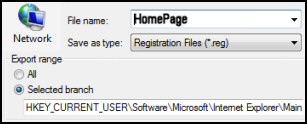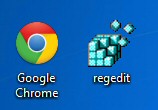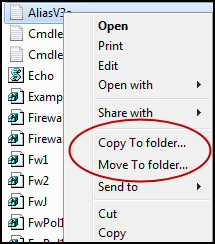Create Windows 8 .Reg Files
While I am happy to show you examples of .reg files for Windows 8, I greatest home is that you will modify my files and thus learn how to create your own .reg files. I have included tips and techniques to help you can create .reg files from scratch.
- 1) Windows 8 Homepage Hi-jack Fix
- How I Made This .Reg File with Regedit Export
- 2) Windows 8 .Reg File Example to Delete a Roaming Cache
- How to Research DeleteRoamingCache with Gpedit
- 3) Windows 8 .Reg File Example to Remove Shortcut Arrow
- 4) ‘Copy To’ Context Menu
♣
1) Windows 8 Homepage Hi-jack Fix
Problem: Malware has hi-jacked your Internet Explorer’s homepage.
Solution: Copy these settings into a text file, and then save with a .reg extension, for example FixHijack.reg. Right-click the file and ‘Merge’ into your registry.
Windows Registry Editor Version 5.00
[HKEY_CURRENT_USER\Software\Microsoft\Internet Explorer\Main]
"Start Page"=""
"Secondary Start Pages"=
; Created by Guy Thomas. Purpose to fix homepage Hi-jack
Note 1: Instead of resetting to a blank page, you could prescribe a real URL, for example:
"Start Page"="www.google.com"
Note 2: The Secondary Start Pages entry may not be necessary in this .reg file example.
How I Made This .Reg File with Regedit Export
This is how I found the homepage reference in the registry. On a machine that was working properly, I set the homepage to an unusual website, a name like fashionera that is unlikely to be found anywhere else in the registry.
Next, I used regedit’s ‘Find’ to locate the unusual website name fashionera. Then I exported this branch of the registry (File Menu, Export).
Note 3: This technique could be used to find other browsers’ setting, e.g. Chrome home page.
2) Windows 8 .Reg File Example – Roaming Profile Cache
Permitting roaming profiles provides a familiar desktop for users who hot-desk. However, a roaming profile can result in a slow logon or confusion. The killer reason to delete roaming profiles is where you have a ‘Kiosk’ machine used by people on a one-off basis. What can happen is that the disk fills up with roaming profiles that will never be used again.
Logic Behind Deleting Roaming Profiles
The first question for deleting roaming profiles is: ‘Where does the cache get deleted? On the server or the Windows 8 computer?’ The answer is on the machine where you set the value, DeleteRoamingCache=1.
Let us spend a minute checking the logic; in this instance a value of 1 means: no roaming caches gets saved. To be clear, 1 means that all roaming profiles get deleted on that Windows 8 computer.
On the other hand, changing to DeleteRoamingCache=0, would be a double negative, (don’t delete), therefore you would end up with roaming profiles!
Guy Recommends: A Free Trial of the Network Performance Monitor (NPM) v11.5
v11.5
SolarWinds’ Orion performance monitor will help you discover what’s happening on your network. This utility will also guide you through troubleshooting; the dashboard will indicate whether the root cause is a broken link, faulty equipment or resource overload.
What I like best is the way NPM suggests solutions to network problems. Its also has the ability to monitor the health of individual VMware virtual machines. If you are interested in troubleshooting, and creating network maps, then I recommend that you try NPM now.
Download a free trial of Solarwinds’ Network Performance Monitor
Windows 8 .Reg File Example to Delete a Roaming Cache
Copy the text below then open Notepad and paste the text. Now, save the file with .reg extension. To inject the settings into your registry just double-click the resulting file.
Windows Registry Editor Version 5.00
[HKEY_LOCAL_MACHINE\SOFTWARE\Microsoft\Windows NT\CurrentVersion\Winlogon]
"DeleteRoamingCache"=dword:00000001
; Created by Guy Thomas. Purpose to delete the roaming cache
Note 4: As this registry setting is in the HKEY_LOCAL_MACHINE hive, it affects the caches of all users.
How to Research DeleteRoamingCache with Gpedit
The key piece of knowledge is realizing that Delete Roaming Cache can be controlled via Windows 8’s Group Policy. You have a choice of editors, GPMC on a domain controller, or what I used was gpedit.msc (remember that .msc). Here is where you find the policy setting:
Computer Configuration: Administrative Templates\System\User Profiles
And the policy: ‘Delete cached copies of roaming profiles’, see screenshot below.
Note 5: This is a policy under Computer Configuration, (and not User Confuration).
The next connection is how to translate a policy setting into a .reg file? There is the cheat technique; if you know the value then you can simply ‘Find’ DeleteRoamingCache in the registry. However, let us assume we don’t know the registry value and decide to research the values from scratch using my before-and-after technique.
- Export the registry with the group policy set to ‘Not Configured’ (see above). Save as Before.reg
- Change the Group Policy to ‘Enabled’
- Export the registry AGAIN, save as After.reg
- Employ PowerShell’s compare-object to isolate the difference. Alternatively call for WinDiff to highlight the differences.
Optionally, you could export only the HKEY_LOCAL_MACHINE branch of the registry. If you guess right, and the setting is in this hive, it will speed up your search. If you guess wrong then you waste time in drawing a blank and having to revert to exporting the whole registry.
 Guy Recommends: The Free Config Generator
Guy Recommends: The Free Config Generator
SolarWinds’ Config Generator is a free tool, which puts you in charge of controlling changes to network routers and other SNMP devices. Boost your network performance by activating network device features you’ve already paid for.
Guy says that for newbies the biggest benefit of this free tool is that it will provide the impetus for you to learn more about configuring the SNMP service with its ‘Traps’ and ‘Communities’. Try Config Generator now – it’s free!
Download your free copy of Config Generator
Instructions to Delete the Roaming Cache
Actually, you don’t have to employ a .reg file at all; you could just edit the registry directly.
- Launch Regedit. (Launch Regedit. (See more details on starting regedit)
- Navigate to this path:
HKLM\SOFTWARE\Microsoft\Windows NT\CurrentVersion\Winlogon - If necessary create a new DWORD called DeleteRoamingCache
- A hex value of 00000001 deletes all local roaming profiles.
- See Screenshot below.
HKLM\Software\Policies\Microsoft\Windows\System See more .reg file examples.
3) Windows 8 .Reg File Example to Remove Shortcut Arrow
If you don’t like arrows on your desktop shortcuts, then this registry tweak is for you. Beware; while this registry tweak is not difficult to achieve you do need to absorb the principles, which I will explain.
The crucial point is that you need a special clear icon file; but don’t worry, just download my noArrow.ico zip file. Once you have the physical file then it’s just a matter of ‘wiring-up’ the key in the registry called ‘Shell Icons’ to the location where you saved the noarrow.ico file.
Windows Registry Editor Version 5.00
[HKEY_LOCAL_MACHINE\SOFTWARE\Microsoft\Windows\CurrentVersion\Explorer\Shell Icons]
"29"="C:\\Guy\noarrow.ico"
; Created by Guy Thomas. Windows 8 Remove Shortcut Arrows.
Employ Notepad to create a .reg file containing the above code. Right-click the file and Merge’.
Here is a step-by-step guide to create a .reg file which will get rid of those annoying arrows ».
Guy Recommends: SolarWinds’ Log & Event Management Tool
LEM will alert you to problems such as when a key application on a particular server is unavailable. It can also detect when services have stopped, or if there is a network latency problem. Perhaps this log and event management tool’s most interesting ability is to take corrective action, for example by restarting services, or isolating the source of a maleware attack.
Yet perhaps the killer reason why people use LEM is for its compliance capability, with a little help from you, it will ensure that your organization complies with industry standards such as CISP or FERPA. LEM is a really smart application that can make correlations between data in different logs, then use its built-in logic to take corrective action, to restart services, or thwart potential security breaches – give LEM a whirl.
Download your FREE trial of SolarWinds Log & Event Management tool.
4) Windows 8 .Reg File Example – ‘Copy To’ Context Menu
I have always found copying a file from folder to another fiddly. Sometimes Windows Explorer develops a mind of its own and drops the file in the wrong place. Moving a file can be worse, the file seems to disappear altogether.
In order to solve this problem I have an option on the context menu to ‘Copy To folder…’, or ‘Move To folder..’ The way I achieve this goal is to merge the .reg file below with the registry. Then when I right-click the file and select ‘Copy to Folder’, a dialog box opens inviting me to choose the file destination. The result is copying or moving files is now fool-proof.
Here are the contents of the actual Copy To .reg file.
Windows Registry Editor Version 5.00
[HKEY_CLASSES_ROOT\AllFilesystemObjects\shellex\ContextMenuHandlers\Guy Copy]
@="{C2FBB630-2971-11d1-A18C-00C04FD75D13} "
Once you copy the above instructions into Notepad, and save with a .reg extension; you are ready to right-click the new .reg file and ‘Merge’ into the registry.
There is no need to logoff, this tweak works straightaway. Launch Windows Explorer, right-click any file and observe the ‘Copy To folder’ context menu option. See Regedit in action with the DaRT recovery tool.
How to Add the ‘Copy To’ to the Explorer Context Menu
- Launch Regedit – ‘Run As Administrator’.
Drill down through HKEY_CLASSES_ROOT, and navigate to this key: - HKEY_CLASSES_ROOT\AllFilesystemObjects\shellex\ContextMenuHandlers\
- Create a new Key. The name does not matter! Traditionally it’s Copy To, but I used Guy Copy.

- In the right-hand pane, you should see an existing REG_SZ called Default. It is this default item that you need to re-program to be:
{C2FBB630-2971-11d1-A18C-00C04FD75D13}
- Note: the {curly brackets} are required for this CLSID.
- Close regedit. This tweak works without having to logoff. Launch Windows Explorer, right-click any file and see ‘Copy To folder’ as a context menu option.
Note 6: Even though I called the key ‘Guy Copy’, Windows Explorer labels it Copy to Folder.
Note 7: You may also notice that Guy Move is highlighted in the above screenshot, and appears in my context menu. To achieve this goal I changed one digit in the CLSID, C2FBB630 to C2FBB631 and then copied the curly brackets and contents to the default in Guy Move.
The full name of the Move To value is:
{C2FBB631-2971-11d1-A18C-00C04FD75D13}
Create the Windows 8 .reg File
One more crucial learning point, Export the registry, and save the file with a .reg extension.
Guy Recommends: SolarWinds Free Wake-On-LAN Utility
Encouraging computers to sleep when they’re not in use is a great idea – until you are away from your desk and need a file on that remote sleeping machine!
WOL also has business uses for example, rousing machines so that they can have update patches applied. My real reason for recommending you download this free tool is because it’s so much fun sending those ‘Magic Packets’. Give WOL a try – it’s free.
Download your free copy of SolarWinds Wake-On-LAN
5) MaintainServerList – Control the Browse Master
MaintainServerList Registry Setting
This setting is useful on small networks without their own DNS server. The concept is that one machine keeps the list of all the computers on the network; the other machines then contact that browse master to find a network machine and its shared folders.
HKLM:\SYSTEM\CurrentControlSet\services\Browser\Parameters\MaintainServerList
Set to Auto, Yes, or No.
See another Windows 8. Reg Example »
Summary of Creating Windows 8 .Reg File Examples
Naturally, I have concrete examples of .reg files, but I hope that you will see how to create your own .reg files by researching the registry settings. My favorite technique is before-and-after using regedit or gpedit.
If you like this page then please share it with your friends
Microsoft Windows 8 Registry Topics
• Windows 8 Overview • Activate Windows 8 Administrator • Windows 8 Remove Shortcut Arrow
• Win 8 Registry Cleaner Review • Windows 7 Style Start Menu • Windows 8 Administrative Shares
• Win 8 Registry • Windows 8 Shortcut Desktop App • Windows 8 .Reg File • Windows 8 AutoRun













